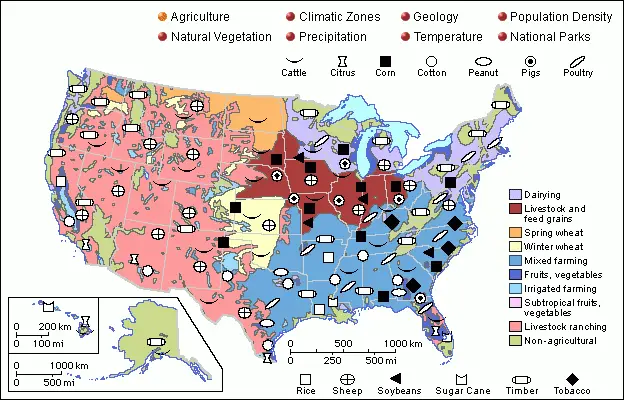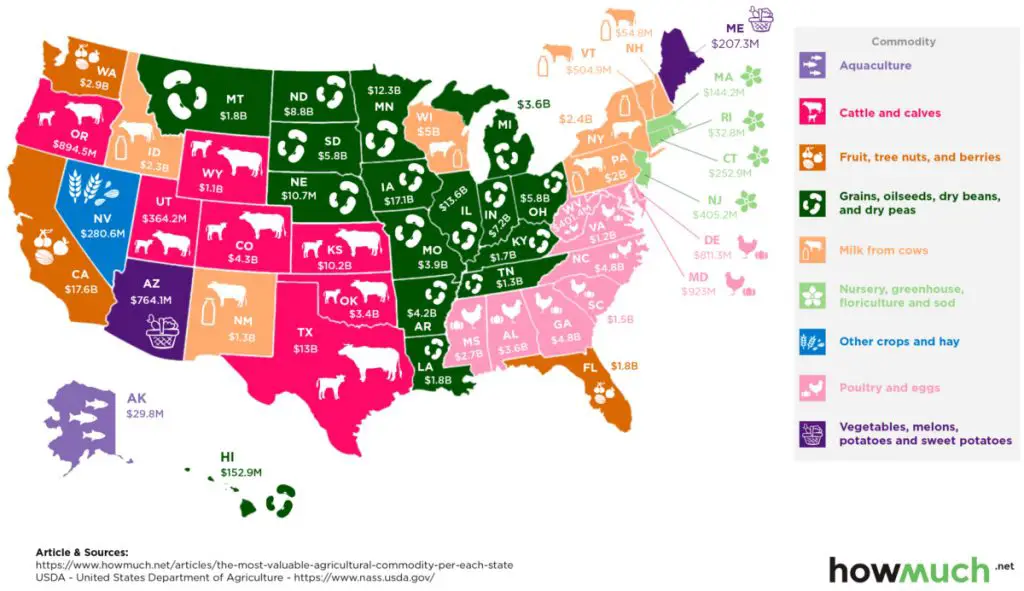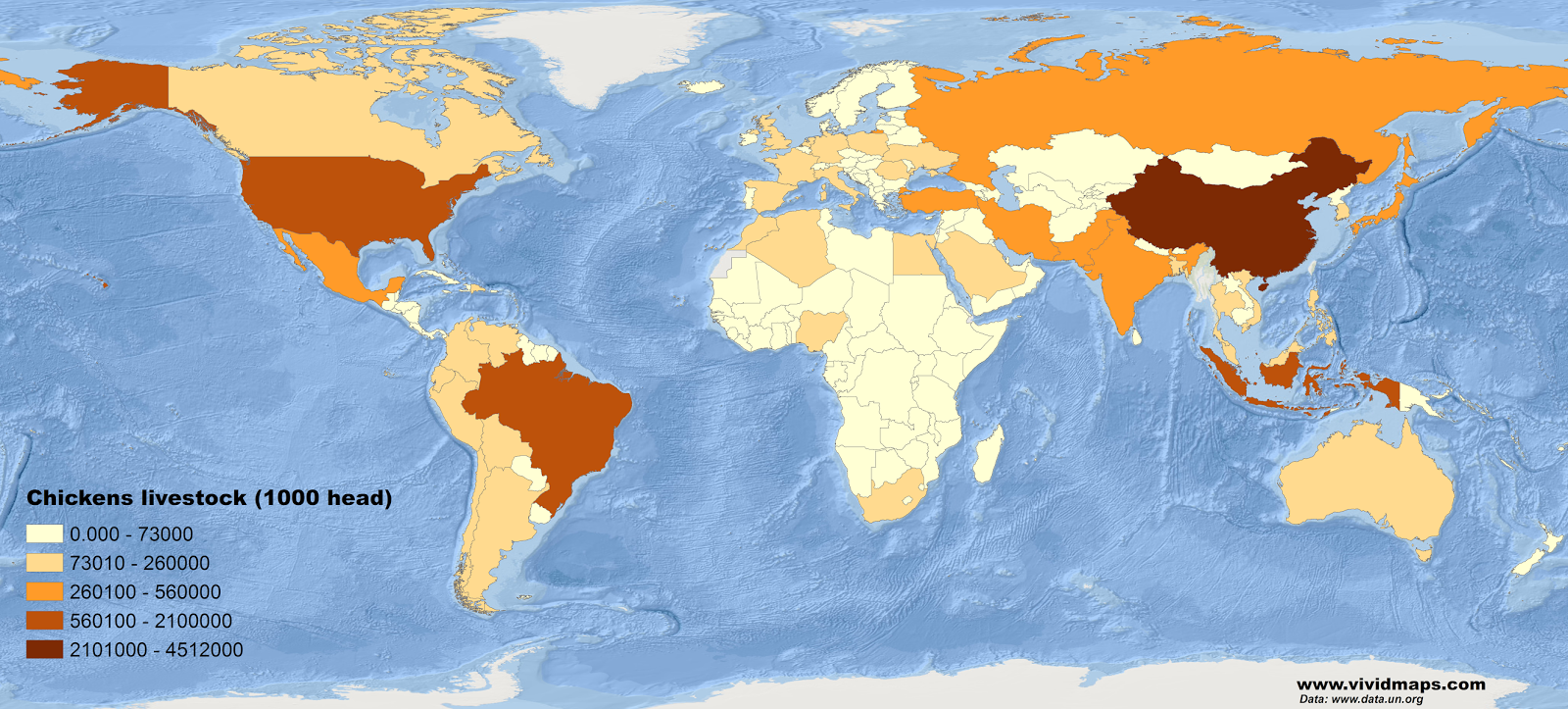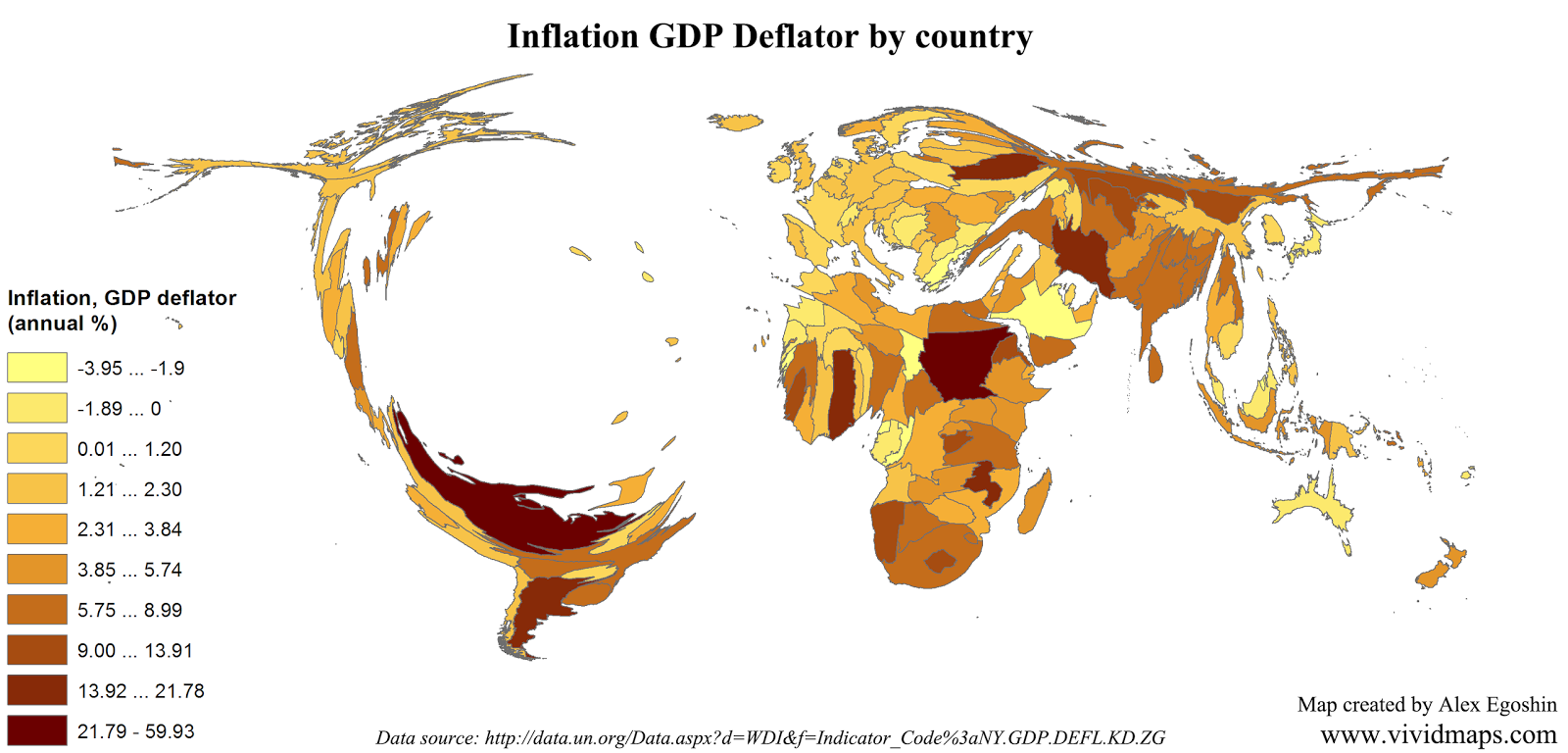Mapping the Most Valuable Agricultural Commodity in Each U.S. State
Table of Contents
Agriculture is a major industry in the U.S., which is a net exporter of food. In the United States, about 2.2 million farms, covering an area of 922 million acres (3,730,000 km2), an average of 418 acres (169 hectares) per farm.
Although agricultural activity occurs in every U.S state in the union, it is particularly concentrated on the west coast, in the Great Plains, a vast expanse of flat, arable land in the center of the nation in the region around the Great Lake.

The United States is a large and diverse country with varied climates, soil conditions, and geographical features. As a result, different regions specialize in the production of specific agricultural commodities based on their unique advantages. Here’s a glimpse into the farming specifics of different areas in the U.S.:
- Corn Belt: Located in the Midwest, the Corn Belt is known for its fertile soil and favorable climate for corn cultivation. States like Iowa, Illinois, Nebraska, and Indiana are major producers of corn, which is used for animal feed, ethanol production, and various food products.
- Wheat Belt: Stretching from the Northern Plains to the Midwest, the Wheat Belt encompasses states such as Kansas, North Dakota, and Montana. These regions have semi-arid climates and suitable soil conditions for wheat farming. Wheat is a significant crop used for bread-making, pasta, and other grain-based products.
- Cotton Belt: The Cotton Belt includes parts of the Southern United States, including states like Texas, Mississippi, and Georgia. This region has a warm climate, long growing season, and adequate rainfall, making it ideal for cotton production. Cotton is used in textiles, apparel, and other cotton-based products.
- Fruit Orchards: California is renowned for its fruit orchards, particularly in the Central Valley region. The Mediterranean climate, fertile soil, and efficient irrigation systems contribute to the production of a wide variety of fruits, including oranges, lemons, grapes, and almonds. Washington State is also known for its apple orchards.
- Dairy Farms: Wisconsin, California, New York, and Pennsylvania are among the top states for dairy farming. These areas have suitable climates, abundant pasturelands, and infrastructure for milk production. Dairy farms produce milk, cheese, butter, and other dairy products.
- Livestock Ranching: The Great Plains, including states like Texas, Kansas, and Oklahoma, are known for their vast cattle ranches. The open grasslands provide ample grazing areas for cattle. These regions also have feedlots where cattle are fattened before slaughter. Pork production is prominent in states like Iowa, North Carolina, and Minnesota.
- Specialty Crops: Various regions specialize in growing specific crops. For example, Florida is known for its citrus fruits, Idaho for potatoes, and Napa Valley in California for wine grapes. Different states also have favorable conditions for growing vegetables, nuts, berries, and other specialty crops.
The map below illustrates the predominant agricultural commodities in each state.

The most valuable agricultural commodity
In the United States, the most valuable agricultural commodity in terms of total production value is typically corn (corn is technically a grain). Corn is widely cultivated across the country and has a diverse range of uses, including animal feed, ethanol production, and various food and industrial applications. The United States is the world’s largest producer and exporter of corn, with major corn-growing states including Iowa, Illinois, Nebraska, and Minnesota.
| U.S. State | Agricultural Commodity | Value |
|---|---|---|
| California | Fruit, tree nuts, and berries | $17,638,972,000 |
| Iowa | Grains, oilseeds, dry beans, and dry peas | $17,146,679,000 |
| Illinois | Grains, oilseeds, dry beans, and dry peas | $13,589,230,000 |
| Texas | Cattle and calves | $13,013,127,000 |
| Minnesota | Grains, oilseeds, dry beans, and dry peas | $12,304,415,000 |
| Nebraska | Grains, oilseeds, dry beans, and dry peas | $10,698,861,000 |
| Kansas | Cattle and calves | $10,153,087,000 |
| North Dakota | Grains, oilseeds, dry beans, and dry peas | $8,813,348,000 |
| Indiana | Grains, oilseeds, dry beans, and dry peas | $7,217,854,000 |
| Ohio | Grains, oilseeds, dry beans, and dry peas | $5,834,600,000 |
| South Dakota | Grains, oilseeds, dry beans, and dry peas | $5,809,792,000 |
| Wisconsin | Milk from cows | $4,952,039,000 |
| North Carolina | Poultry and eggs | $4,837,026,000 |
| Georgia | Poultry and eggs | $4,773,837,000 |
| Colorado | Cattle and calves | $4,321,308,000 |
| Arkansas | Grains, oilseeds, dry beans, and dry peas | $4,214,355,000 |
| Missouri | Grains, oilseeds, dry beans, and dry peas | $3,922,873,000 |
| Alabama | Poultry and eggs | $3,624,852,000 |
| Michigan | Grains, oilseeds, dry beans, and dry peas | $3,613,250,000 |
| Oklahoma | Cattle and calves | $3,402,919,000 |
| Washington | Fruit, tree nuts, and berries | $2,931,370,000 |
| Mississippi | Poultry and eggs | $2,744,048,000 |
| New York | Milk from cows | $2,417,398,000 |
| Idaho | Milk from cows | $2,333,364,000 |
| Pennsylvania | Milk from cows | $1,966,892,000 |
| Florida | Fruit, tree nuts, and berries | $1,847,805,000 |
| Louisiana | Grains, oilseeds, dry beans, and dry peas | $1,832,208,000 |
| Montana | Grains, oilseeds, dry beans, and dry peas | $1,787,162,000 |
| Kentucky | Grains, oilseeds, dry beans, and dry peas | $1,656,983,000 |
| South Carolina | Poultry and eggs | $1,476,817,000 |
| Washington | Fruit, tree nuts, and berries | $2,931,370,000 |
| Mississippi | Poultry and eggs | $2,744,048,000 |
| New York | Milk from cows | $2,417,398,000 |
| Idaho | Milk from cows | $2,333,364,000 |
| Pennsylvania | Milk from cows | $1,966,892,000 |
| Florida | Fruit, tree nuts, and berries | $1,847,805,000 |
| Louisiana | Grains, oilseeds, dry beans, and dry peas | $1,832,208,000 |
| Montana | Grains, oilseeds, dry beans, and dry peas | $1,787,162,000 |
| Kentucky | Grains, oilseeds, dry beans, and dry peas | $1,656,983,000 |
| South Carolina | Poultry and eggs | $1,476,817,000 |
| West Virginia | Poultry and eggs | $401,439,000 |
| Utah | Cattle and calves | $364,214,000 |
| Nevada | Other crops and hay | $280,554,000 |
| Connecticut | Nursery, greenhouse, floriculture and sod | $252,923,000 |
| Maine | Vegetables, melons, potatoes and sweet potatoes | $207,254,000 |
| Hawaii | Grains, oilseeds, dry beans, and dry peas | $152,930,000 |
| Massachusetts | Nursery, greenhouse, floriculture and sod | $144,188,000 |
| New Hampshire | Milk from cows | $54,798,000 |
| Rhode Island | Nursery, greenhouse, floriculture and sod | $32,831,000 |
| Alaska | Aquaculture | $29,774,000 |
Nevertheless, each state has its own most profitable crop.
The most lucrative food crop
The map below created by huffingtonpost shows the most lucrative crop in each U.S. state.

The most lucrative food crop in the United States can vary depending on factors such as market demand, pricing, and production costs. However, some of the food crops that have traditionally been considered lucrative in terms of profitability and economic value include:
- Almonds: Almonds have experienced significant growth in demand due to their nutritional benefits and versatility. California is the primary almond-producing state in the U.S., and the crop has been highly profitable for farmers in recent years.
- Pistachios: Similar to almonds, pistachios have seen a rise in demand and profitability. California is the dominant producer of pistachios in the U.S., and the crop has become increasingly valuable for farmers in the state.
- Apples: Apples are a widely grown fruit in various regions of the United States, including states like Washington, New York, Michigan, and California. Apples are profitable for farmers due to their versatility in the fresh fruit market, as well as for processing into products like apple juice, applesauce, and pies.
- Berries: Various types of berries, including strawberries, blueberries, and raspberries, have gained popularity and profitability in recent years. These fruits are in high demand due to their health benefits and are cultivated in several states, including California, Florida, Oregon, and Washington.
- Leafy Greens: Leafy greens, such as lettuce, spinach, and kale, have a consistent demand and high profitability due to their use in salads, smoothies, and as ingredients in various culinary preparations. States like California, Arizona, and Florida are major producers of leafy greens in the U.S.
Top Agricultural Crop in Each U.S. State
The United States Cow Inventory
The United States is one of the largest producers of beef and dairy cattle. The cattle population in the U.S. was estimated to be around 94 million head in 2020.
Nebraska has the highest population density of cattle per square mile (83.4 head of cattle per square mile) .
The best farmland in the U.S.
The United States has several regions known for their fertile farmlands. The suitability of farmland varies based on factors such as climate, soil quality, water availability, and market conditions. Here are some regions often recognized for their productive farmlands:
- Midwest (Corn Belt): The Midwest region, including states like Iowa, Illinois, Indiana, Nebraska, and Kansas, is often referred to as the Corn Belt. It is known for its deep, rich soils and favorable climate for corn and soybean production. The Midwest is also well-suited for other crops like wheat and oats.
- California’s Central Valley: California’s Central Valley is renowned for its highly productive farmlands. The region benefits from fertile soils, a Mediterranean climate, and access to irrigation water from the Sierra Nevada Mountains. It is a major producer of fruits, vegetables, nuts, and dairy products.
- Pacific Northwest: The Pacific Northwest region, comprising states like Washington, Oregon, and Idaho, offers productive farmlands. The area benefits from a mild climate, ample rainfall, and diverse soil types. It is known for its production of apples, cherries, potatoes, wheat, and other crops.
- Mississippi Delta: The Mississippi Delta region, located in the southern United States, has fertile alluvial soils and a long growing season. It is particularly suitable for crops like cotton, rice, soybeans, corn, and various vegetables.
- Great Plains: The Great Plains region, stretching from Texas to North Dakota, offers extensive farmlands. It has fertile soils and a semi-arid to sub-humid climate. The region specializes in the production of wheat, corn, soybeans, sorghum, and cattle ranching.
- Southeast: The Southeastern United States, including states like Georgia, Florida, and North Carolina, has fertile soils and a humid subtropical climate. The region is known for crops such as peanuts, tobacco, citrus fruits, sweet potatoes, and cotton.
- Northeast: The Northeastern region, including states like New York, Pennsylvania, and Vermont, has productive farmlands despite its smaller size. The area specializes in dairy farming, as well as the production of fruits, vegetables, and maple syrup.
The map below shows agricultural lands best suited for intensive food and crop production.









Hi, I up-voted above, and it registered as a down vote…FYI. This is a great site. A lot of easy to understand info with the maps. You should fix the vote thing, or remove it.
Im doing this for school
I am doing this for school